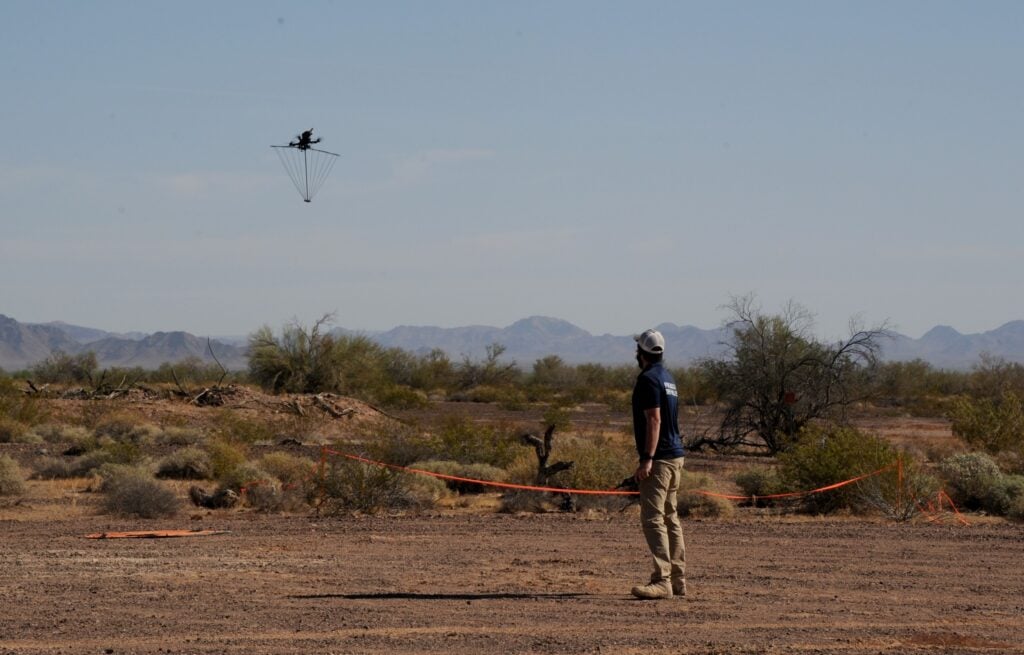
DoD held its first demo of tech to counter small drones April 5-9, 2021 at Yuma Proving Ground, Arizona.
WASHINGTON: DoD’s joint office to counter small drones small drones will hold a second set of industry demos and looks likely to invite new participants.
“We’re keeping all options on the table,” Army Col. Greg Soulé, director of acquisition & resources at the Joint Counter-small Unmanned Aerial Systems Office (JCO), told reporters today.
The first demo, held April 5-9 at Yuma Proving Ground, focused on what DoD calls Low Collateral Effects Interceptors (LCEI): systems that can be used to knock out small drones in crowded airspace or urban areas without hurting civilians, civil infrastructure or friendly troops. The three contenders were tested against lightweight Group 1 UAS, according to an Army press release.
Those tests dealt with one incoming drone at a time, as the types of counter-sUAS systems involved “aren’t really intended to address a swarm-type threat,” Soulé said.
Group 1 drones weigh less than 20 pounds, operate below 1,200 feet and generally with a speed less than 100 knots. “These type of drones are small and quick, hard to mitigate and can carry various payloads, including surveillance equipment,” the Army release said.
DoD tapped the Army to lead the JCO as the department’s Executive Agent last January. The Air Force, however, is the designated lead for developing LCEI. The other services have the lead on development of different types of counter-drone weapons.
“While the JPO has led the demonstration event, the Air Force has been engaged throughout the planning, execution, and evaluation,” Air Force Lt. Col. Eric Like, materiel leader for cyber integration and transition at the Air Force Research Laboratory’s Information Directorate, said during today’s briefing.
The Army Rapid Capabilities and Critical Technologies Office (RCCTO) also is involved, hosting the first round of demos.
The three companies involved – Aurora Flight Sciences, ELTA North America, and XTEND – were down-selected from some 30 respondents to the JCO’s January RFI.
Aurora Flight Sciences, a Boeing subsidiary, brought its Modular Intercept Drone Avionics Set (MIDAS) is an “AI-enabled, multi-rotor sUAS outfitted with optical sensors and a customized payload that can defeat multiple sUAS per flight with low-collateral effects,” according to the firm’s website. The system is essentially a defensive drone that shoots down enemy ones.
ELTA North America — the US arm of Israeli firm ELTA Systems, itself a part of Israel Aerospace Industries — demonstrated the Drone-Kill-Drone (DKD) system, designed to be 100 percent autonomous once launched. Another drone-killing drone, it uses a wire net to entangle the rotors of hostile drones in flight.
XTEND, an Israeli startup specializing in augmented reality systems, brought its SKYLORD GRIFFON system, which uses “human centric” navigation such as augmented reality to allow even operators with no flight experience to use it. The system also uses a metal ‘net’ to down adversary drones.
“We’re now in the process of planning our second demonstration in September,” explained Leland Browning, JCO acting deputy director. “We’re currently in the process of consolidating and analyzing the data that was obtained during the demonstration, and we will meet with the participating vendors to provide feedback, along with the Air Force.”
While officials at the briefing were a big vague about the details, the overall plan is to hold two demonstrations a year over the next couple of years — focused on different types of adversary drones and different types of counter-systems.
“So, our next demo is in the planning stages right now. They were planning the second demo as we went into the first one so we get into a battle rhythm of doing [one] twice a year,” said Stan Darbro, RCCTO deputy director. “I think it’s September you’ll see us open up up the aperture, looking at other capabilities besides low-collateral effects. We’re working through this process and exactly what areas right now.”
Move over FARA: General Atomics pitching new Gray Eagle version for armed scout mission
General Atomics will also showcase its Mojave demonstrator for the first time during the Army Aviation Association of America conference in Denver, a company spokesman said.


























